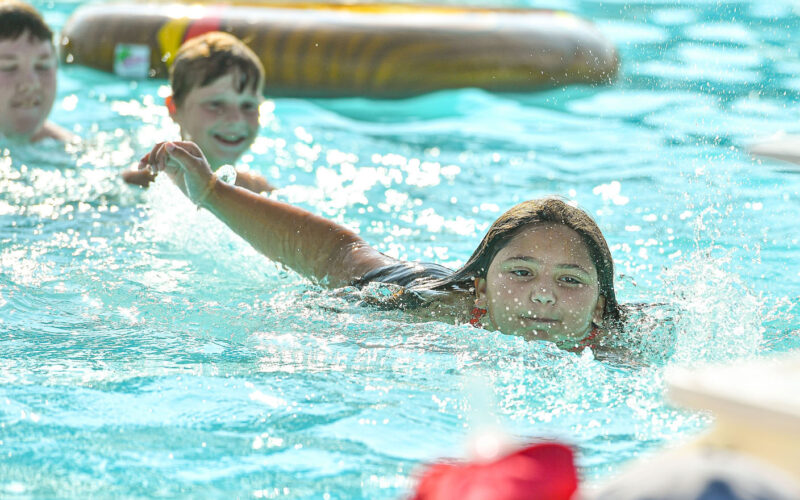Q. I just moved to an apartment complex with a great outdoor swimming pool. At this time of year I plan to swim most days, but don’t want to jeopardize my health. I’ll bet you have good suggestions for ways to use the pool without causing health problems? What are some of them?
A. You are wise to consider how to be at the pool more safely because the benefits from regular exercise are certainly worthwhile. Health risks from the sun, heat, and dehydration, can all be mitigated with some advance preparation and attention while at the pool.
Sunscreen is the most recommended precaution, with good reason. Liberally applied sunscreen with a high SPF rating (Sun Protective Factor) to all exposed areas of your skin is essential. Keep in mind that “exposed areas” include those receiving reflected light (such as the forehead below wide brims), breakthrough light (with mesh and lightweight clothing), and those that initially seemed covered (thighs under trunks, upper arms initially covered by shirts, and your whole top when you remove it). Reapply regularly—sunscreen loses effectiveness as time passes. For those who don’t like traditional sunscreen, moisturizing lotions with high protection numbers (such as CeraVe AM Facial Moisturizing Lotion with SPF 30) work well as substitutes.
Besides merely using sunscreen, a broader approach to total UV protection, such as wearing clothing items made of sun protective fabrics and a few other steps, also make sense.
The variety of clothing choices that can reduce sun risk, discomfort, and injury include:
Sun Protective (UPF) Clothing is a type of clothing that most men are not familiar with. It has a number rating, UPF (ultraviolet protection factor) that represents the ratio of sunburn-causing UV measured with and without the protection of the fabric. For example, a fabric rated UPF 30 means that, if 30 units of UV fall on the fabric, only 1 unit will pass through to the skin. Clothing rated UPF 50 offers even more protection.
Rash Guard: A form-fitting athletic shirt that protects your skin from chafing, sunburn, and board rash.
Swim Shirts: These tend to be more like regular clothing, providing high UPF protection.
Sun Shirts: UPF clothing with wicking properties better suited for activities out of the water.
Sunglasses: Wear ones that offer 100% UV-ray protection.
Hats: Wear one in sunny weather, especially if you are balding. They can be standard wool fedoras or more casual cotton styles. One of the long-established makers of casual, cotton hats for men is Kangol; their bucket hats and peaked, baseball-type caps have been popular for years.
In addition, getting enough fluids is essential in the heat. This is even more true if you’re having an alcoholic drink during your time by the pool. It is important to bring a Water Bottle; drink and refill it. It’s the key part of your gear to prevent dehydration.
Finally, limit the amount of time you expose yourself to UV radiation, especially during peak daylight hours — roughly from 9am to 3pm. In other words, swim early or late in the day. Remember that sun protection isn’t just for sunny days; filtered sun can still damage your skin. Protect yourself even on cloudy days. You should assume that any time in summer months that your body is exposed to the sun, it needs protection and hydration.
Please send your men’s dress and grooming questions and comments to MALE CALL: Lois.Fenton@prodigy.net









